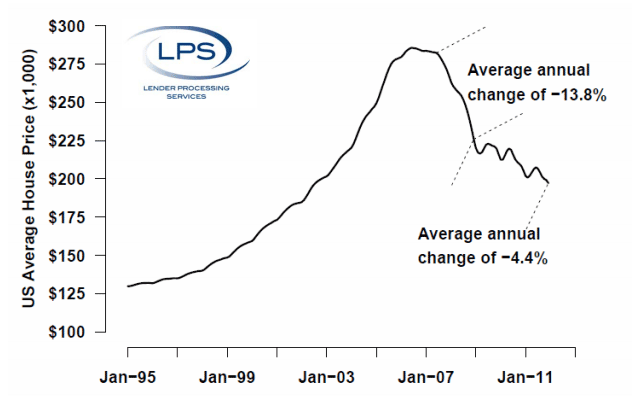Blog

Two Surveys Show Home Prices Lowest in 10 Years, Down 31% Since Peak in 2006
Two companies released home price datarnon Wednesday. CoreLogic released itsrnHome Price Index (HPI) for the month of January while Lender ProcessingrnServices (LPS) released numbers for December.</p
The LPS national HPI in December wasrnthe lowest since September 2002 with an average house price in December of $197,000,rndown $2,000 from the November number. December was the sixth consecutive month inrnwhich home prices declined and the actual decline of 1.0 percent was higherrnthan the 0.8 percent that had been predicted. rnLPS is projecting a further decline in January to $195,000 or a -1.2rnpercent change.</p
While prices are still dropping, atrnleast the rate of decline is less steep. rnDuring the period of most rapid decline – June 2007 to December 2008 -rnprices fell an average of 13.8 percent a year. rnSince then the annual rate has been 4.4 percent. </p
 </p
</p
Aggregate home values are down 31rnpercent since the peak in June 2006, declining from $10.8 trillion to $7.5rntrillion.</p
LPS said that December figuresrnappear to have continued a seasonal pattern that has modulated prices sincern2009. Seasonal variations seem to occurrnin the market for non-distressed home sales but short sales do not vary overrnthe year nearly as much. Therefore thernapparently significant seasonal effects that LPS and others have reported havernbeen influenced by the large proportion of short sales after the bubble. These sales have been treated as if theyrnexperienced typical seasonal variations and thus have exaggerated seasonalrnprice variations. LPS said thatrnbeginning next month it will institute updated HPI non-distressed sales whichrnwill even out the seasonal variations.</p
In 44 states all of the MSAs thereinrnhad price declines in December, a total of 373 of the 411 MSAs covered byrnLPS. Prices also fell in 28 MSAs inrnother states. Only Phoenix and Miami hadrnaverage prices increases during December while San Francisco, San Diego,rnDetroit, Chicago, and Atlanta all had declines that exceeded 1.5 percent.</p
Raj Dosai, vice president of LPSrnsaid that despite the broad price declines since the bubble, not all MSAs havernseen consistent price drops. “Aboutrnone-fifth (89) of all the MSAs that LPS covers have seen average home pricesrnincrease since December 2008. For 90rnpercent of these MSAs, prices rose only as the lowest-priced homes in theirrnmarkets rose. This correlation did notrnnecessarily hold for higher-priced homes in those areas. Unfortunately, the MSAs that have seen pricernincreases since December 2008 are generally small. Boston and Pittsburgh are exceptions.”</p
CoreLogic tracks home sales includingrndistressed sales (short sales and sales of lender owned real estate or REO.) Its HPI for January declined on arnyear-over-year basis by 3.1 percent and on a month-over-month basis by 1.0rnpercent, the sixth consecutive monthly decline. rnWhen distressed home sales are excluded the HPI narrows to a 0.9 percentrndecline year-over-year and there was a 0.7 percent increase in prices sincernDecember.</p
“Although home price declinesrnare slowly improving and not far from the bottom, home prices are down tornnearly the same levels as 10 years ago,” said Mark Fleming, chiefrneconomist for CoreLogic.</p
States with the largest increase inrnHPI were South Dakota (+5.7 percent), North Dakota (+4.0 percent) and WestrnVirginia (+4.0). When distressed salesrnare excluded the greatest increases were South Dakota (+6.4 percent), Montana (+5.9rnpercent) and North Dakota (+3.8 percent).</p
The largest depreciation in homernprices was noted in Illinois (-8.7 percent), Nevada (-8.0 percent, and Delawarern(-7.9 percent.) When distressed salesrnare not included the greatest depreciation was in Nevada (-6.7 percent),rnDelaware (5.5 percent), and Minnesota (-4.1 percent.) </p
Including distressed transactions,rnthe peak-to-current change in the national HPI (from April 2006 to Januaryrn2012) was -34.0 percent. Excluding distressed transactions, the peak-to-currentrnchange in the HPI for the same period was -24.2 percent.
All Content Copyright © 2003 – 2009 Brown House Media, Inc. All Rights Reserved.nReproduction in any form without permission of MortgageNewsDaily.com is prohibited.
Latest Articles
By John Gittelsohn August 24, 2020, 4:00 AM PDT Some of the largest real estate investors are walking away from Read More...
Late-Stage Delinquencies are SurgingAug 21 2020, 11:59AM Like the report from Black Knight earlier today, the second quarter National Delinquency Survey from the Read More...
Published by the Federal Reserve Bank of San FranciscoIt was recently published by the Federal Reserve Bank of San Francisco, which is about as official as you can Read More...

Comments
Leave a Comment